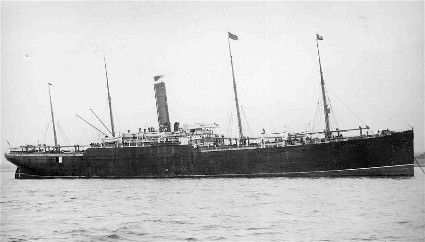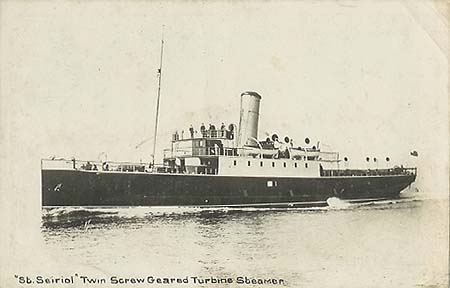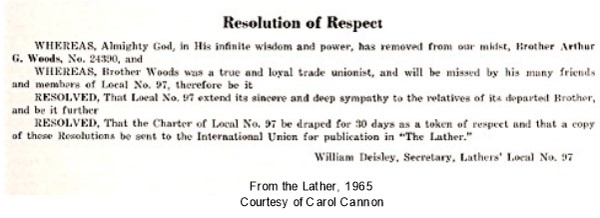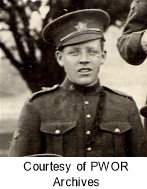|
Feb 26, 1896
|
Born in Pamber, England to Joseph and Esther (nee
Stacey) Woods
|
|
Apr 23, 1912
|
Embarked the SS Ultonia in Southampton

|
|
May 6, 1912
|
Disembarked in Halifax, Nova Scotia and proceeded
to Toronto, Ontario
|
|
Dec 7, 1914
|
Attested into the 21st Battalion CEF
in Kington, Ontario
Ø Number 60097 (temporary number
1040)
Ø Next of kin given as Mrs.
Elsie Monger, sister, 14 Drayton Avenue, Toronto, Ontario
Ø Previous occupation given as
Lather
Ø No previous military
experience given
Ø Religion given as Presbyterian
Ø Posted to “B” Company
o
this
was later reorganized into “A” Company
o
performed
as a Bugler in the Drum and Bugle Band
The battalion trained in the Kingston area
through the winter with headquarters in the Kingston Armories
|
|
May 6, 1915
|
Embarked the RMS Metagama in Montreal, Quebec

|
|
May 15, 1915
|
Disembarked in Devonport, England and the
battalion proceeded to the West Sandling Camp, near Hythe, Kent to continue
training.
|
|
Aug 16, 1915
|
Forfeits 6 days pay for absence from Aug 11-16
and restricted to half pay for 3 months
|
|
Sep 14, 1915
|
Embarked the St. Seiriol in Folkestone, England.

|
|
Sep 15, 1915
|
Disembarked in Boulogne, France and the battalion
proceeded to St. Omer
|
|
Sep 25, 1915
|
While in the front line trench near Messines, Belgium, Private
Woods received a non-serious shrapnel wound to his scalp and was evacuated to
a nearby field ambulance for first aid
|
|
Sep 26, 1915
|
Transferred to the No. 8 CCS (Casualty Clearing Station)
|
|
Sep 29, 1915
|
Transferred to No. 8 Stationary Hospital, Wimereux, France for
head wound. Experiencing periods of
vertigo.
|
|
Oct 1, 1915
|
Transferred to No. 5 Convalescent depot, Wimereux
|
|
Oct 13, 1915
|
Discharged to Base Details, #5 Convalescent
Depot, Wimereux
|
|
Oct 24, 1915
|
Transferred to camp Base Depot at the Rouelles
Camp, Havre, France
|
|
Oct 31, 1915
|
Proceeded to join the 21st Battalion
|
|
Nov 3, 1915
|
Rejoined the battalion resting in La Clytte,
Belgium
|
|
Nov 22, 1915
|
To Bombing School
|
|
Nov 28, 1915
|
To duty from Bombing School
|
|
Mar 21, 1916
|
While in the front line trench near Voormezeele,
Belgium, Private Woods received a bruised shoulder from the explosion of a
trench mortar
|
|
Mar 22, 1916
|
Admitted to the No. 5 Canadian Field Ambulance
(C.F.A.) for contusion to left shoulder from trench mortar.
|
|
Mar 23, 1916
|
Transferred to the No. 6 C.F.A. Divisional Rest
Station
|
|
Apr 1, 1916
|
Discharged to duty and rejoined the 21st
Battalion
|
|
Apr 5, 1916
|
Admitted to the No. 1 Northumbrian Field
Ambulance suffering from Neurasthenia and transferred to the No. 4 Canadian
Field Ambulance. After being assessed,
he was transferred to the No. 17 Casualty Clearing Station where he boarded
the No. 23 AT (Ambulance Train) and transferred to the No. 3 Canadian General
Hospital in Boulogne, France for Neurasthenia – shell shock
|
|
Apr 26, 1916
|
Transferred to the No. 1 Convalescent Depot in
Boulogne, France for shell shock
|
|
May 1, 1916
|
Discharged to Base Details in Boulogne
|
|
May 6, 1916
|
Transferred to the No. 3 General Base Depot in Havre,
France
|
|
May 9, 1916
|
To Canadian Base Depot in Havre, France
|
|
May 18, 1916
|
Classified P.B. (permanent base) by the medical
board and transferred to CCAC in Folkestone, England
|
|
May 19, 1916
|
Invalided to England
|
|
May 22, 1916
|
Examined by the Medical Board in Shorncliffe,
England which states that he was diagnosed with Shell Shock in March
1916. States he just returned
from France and is nervous. Granted furlough from May 22,1916 to June 23
|
|
Jul 4, 1916
|
Taken on strength to the 39th Reserve
Battalion, West Sandling, England for 8 weeks base duty
|
|
Aug 11, 1916
|
Medical Board, West Sandling Camp – disability of
neurasthenia (shell shock) due to effects of wound to the head and shoulder
from a shell explosion
|
|
Oct 10, 1916
|
Medical Board, West Sandling Camp, states he
suffers from a contusion of shoulder and shell shock
|
|
Oct 24, 1916
|
Medical Board at West Sandling states that he has
a wound to the head, contusion of shoulder and shell shock. Says last injury
was March 28 when he suffered from shell shock. No signs of nervous
exhaustion now. Tremor in hands. It
says he will be fit for duty in 4 weeks
|
|
Nov 4, 1916
|
To Canadian Command Depot for 4 weeks for P.T.
(physical training) at the St. Leonard’s Hospital, in Stonehaven, Scotland
|
|
Nov 6, 1916
|
Ceases to be attached and reports to Canadian Casualty
Assembly Centre in West Sandling
|
|
Nov 10, 1916
|
Reported to be AWL (Absent Without Leave)
|
|
Nov 15, 1916
|
In arrest for being A.W.L. from Nov. 10 to Nov. 15. Given 7 days Field Punishment
# 2 and forfeited 14 days pay
|
|
Mar 10, 1917
|
S.O.S. on transfer to the Eastern Ontario
Regimental Depot in Seaford
|
|
Mar 15, 1917
|
T.O.S. (Taken on Strength) 6th Reserve
Battalion in Seaford
|
|
Apr 17, 1917
|
Admitted to Brigade Hospital with a diagnosis
that reads VDG (Venereal Disease Gonorrhea)
|
|
Apr 20, 1917
|
Discharged from Brigade Hospital
|
|
Apr 30, 1917
|
re-admitted to Brigade Hospital, Seaford, England
for Venereal Disease Gonorrhea.
There is no entry for his discharge from
hospital. It is possible this was just
a 1 day visit for treatment
|
|
Aug 31, 1917
|
Forfeited 14 day’s pay for failing to comply with
6th Reserve Battalion orders
|
|
Mar 2, 1918
|
Admitted to the No. 14 Canadian General Hospital
in Eastbourne, England for Tonsillitis
|
|
May 24, 1918
|
Transferred to E.O.R.D. (Eastern Ontario
Regimental Depot) on reporting to 3rd Canadian Command Depot,
category “D”
|
|
Jul 8, 1918
|
Admitted to Canadian Etchinghill Hospital,
England for Venereal Disease Gonorrhea.
Ceases on command 3rd CCD on being admitted
to hospital
|
|
Nov 16, 1918
|
Discharged from hospital and attached to 3rd
CCD for Physical Training
|
|
Nov 27, 1918
|
Reported to be absent
|
|
Nov 28, 1918
|
Ceases to be attached having been declared
illegally absent from Nov 27,1918 and having deficiencies of kit to the
amount of £11.
Transferred to the 6th Reserve
Battalion in Seaford
|
|
Dec 13, 1918
|
On command to Military District No. 2, Kinmel
Park, Rhyl pending dispatch to Canada
|
|
Dec 17, 1918
|
Medical exam at Kinmel Park, Wales and deemed to
be in good health
|
| Jan 18, 1919 |
Embarked the SS Aquitania in Liverpool
|
|
Jan 24, 1919
|
Arrived in Halifax, Nova Scotia and proceeded to
Toronto, Ontario where he was posted to the Military District No. 2 Casualty Company
in the Exhibition Camp
|
|
Jan 30, 1919
|
Granted leave until February 14, 1919
|
|
Feb 17, 1919
|
Toronto, Exhibition Place – Medical Board - Upon
examination he is said to be suffering from Myalgia and Neurasthenia as a
result of his war time service and therefore has partial loss of his muscular
and nervous system. Placed in category
“E”, Unfit for service as he cannot return to his former occupation of lather
due to dizziness and tremors. Also suffers from insomnia and awakens to feel
he is choking.
|
|
Feb 22, 1919
|
Discharged from the CEF at Exhibition Camp
Toronto, Ontario
Ø Rank on discharge Private
Ø War Service Badge Class “A”
issued number 88148
Ø War Service Badge Class “B”
issued number 54031
Ø Proposed residence on
discharge 150 King Edward Ave., East Toronto, Ontario
He is to receive 15% disability
and should improve in 6 months
Following his discharge, the 1914-15 Star,
British War Medal and Victory Medals were sent to him at 113 Newmarket Ave.,
Toronto, Ontario
He lived the rest of his life in Toronto and it
seems he was indeed able to continue his occupation as a Lather. He was a
member of the “Wood, Wire and Metal Lathers’ International Union” and part of
Local Union #97 in Toronto (his number #24390) until his death in 1964. He served as Recording Secretary for the
local Union in the years 1940 and 1941.
|
|
Mar 27, 1920
|
Married Eva Alma Gibb in Toronto, Ontario
According to the Lathers Union publication Arthur
George Woods passed away sometime in 1964 in Toronto. He and his wife had no surviving children.
|
|

|
|

